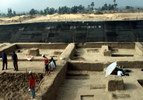|
Kafr
Hassan Daoud is located in the Wadi Tumilat of northeastern
Egypt, and provides evidence of cemetery use during the
Predynastic and Graeco-Roman Periods. Excavations of the
predynastic cemetery were directed by Dr. Nancy Lovell in
the summer of 1995, after a reconnaisance visit to the site
in February of that year. Archaeologists working for the
Supreme Council of Antiquities had begun excavations at
the site some years earlier.
A total of 26 burials of the Pre / Early Dynastic and Graeco-Roman
Periods were exposed during excavations of the cemetery
at Kafr Hassan Daoud in 1995. The Graeco-Roman graves, none
of which were excavated in 1995, are all oriented on an
east-west axis and appear to consist of simple mud and brick
tombs. Eighteen Pre / Early Dynastic burials were excavated.
Most were dug as simple pits in the sand and did not include
grave offerings other than pieces of crude pottery, although
the extent of grave-robbing in antiquity is unclear. One
of these pit graves is distinguished by its relatively rich
grave accompaniments. Two graves of this period are characterized
by mud-brick superstructures and quantities of schist and
alabaster vessels, and have clear parallels to the elite
tombs of Minshat abu Omar. The skeletal remains from Pre
/ Early Dynastic graves were poorly preserved, but enough
biological data was obtained to ascertain that use of the
cemetery was not restricted by age or sex. Low frequencies
of arthritis, trauma, infection, and dental disease suggest
generally good health among the inhabitants of the early
community, although enamel defects of the teeth indicate
that many adults had survived severe illness or malnutrition
during childhood.
|
|
Publications
2000
Lovell, Nancy C. The 1995 Excavations at Kafr Hassan
Daoud. Journal of the Society for the Study of
Egyptian Antiquities 27:34-41.
|
|


